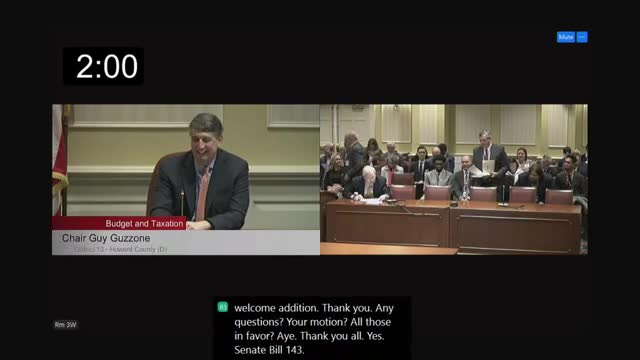Bill would let state buy oblique aerial imagery to improve property assessments, department says could raise revenue
January 15, 2025 | Budget and Taxation Committee, SENATE, SENATE, Committees, Legislative, Maryland
This article was created by AI summarizing key points discussed. AI makes mistakes, so for full details and context, please refer to the video of the full meeting. Please report any errors so we can fix them. Report an error »

A bill before the Senate Budget and Taxation Committee would authorize the Department of Assessments and Taxation (SDAT) to acquire oblique aerial imagery — angled photographs taken from aircraft — to improve property assessment accuracy, department officials told legislators.
Dan Phillips, director of SDAT, said oblique imagery can allow assessors to measure buildings from angles that top-down satellite or lidar imagery cannot, identifying additions, rooftop features and structures set back from roads that are otherwise missed. The department’s study, Phillips said, estimated the technology could uncover roughly $1.4 billion in additional assessable base and could generate more than $14 million annually in additional revenue for counties statewide.
Witnesses said oblique imagery can be processed faster: on average the technology can accomplish in one hour what would otherwise take an assessor three hours. Department testimony added that the imagery frees staff to focus on more complex appeals and densely populated areas that require in-person inspection. SDAT said the imagery is currently available in nine counties, including Baltimore City, through vendor partnerships and cooperation with local jurisdictions.
Committee members asked whether drones would be used; SDAT said the imagery would be captured from airplanes at FAA-allowed altitudes, not drones. Senators also asked how the images are stored and who has access. The department said vendors store imagery, and that participating counties have access through cooperative agreements. SDAT described the images as clear enough to measure building dimensions but generally not sufficient to identify individuals in the photos; the department compared the clarity to satellite images rather than ground-level street view, which undergoes face-blurring.
Officials told the committee that the imagery would not change appeal procedures: homeowners may still appeal assessments and hearings would be conducted by an assessor via telephone, in-person, video or written hearing. The department said staff would not be replaced; rather, the technology helps compensate for limited assessor staffing that prevents inspections every three years in all locales.
Questions also covered overlap with existing imagery from other state agencies: SDAT said satellite imagery and lidar used by natural-resources agencies differ from oblique imagery and capture different measurements; agricultural or nutrient-management imagery tends to be top-down and uses other technical approaches.
Supporters urged a favorable report; some senators asked SDAT to provide sample photos and guidance on privacy and use at a follow-up briefing.
Dan Phillips, director of SDAT, said oblique imagery can allow assessors to measure buildings from angles that top-down satellite or lidar imagery cannot, identifying additions, rooftop features and structures set back from roads that are otherwise missed. The department’s study, Phillips said, estimated the technology could uncover roughly $1.4 billion in additional assessable base and could generate more than $14 million annually in additional revenue for counties statewide.
Witnesses said oblique imagery can be processed faster: on average the technology can accomplish in one hour what would otherwise take an assessor three hours. Department testimony added that the imagery frees staff to focus on more complex appeals and densely populated areas that require in-person inspection. SDAT said the imagery is currently available in nine counties, including Baltimore City, through vendor partnerships and cooperation with local jurisdictions.
Committee members asked whether drones would be used; SDAT said the imagery would be captured from airplanes at FAA-allowed altitudes, not drones. Senators also asked how the images are stored and who has access. The department said vendors store imagery, and that participating counties have access through cooperative agreements. SDAT described the images as clear enough to measure building dimensions but generally not sufficient to identify individuals in the photos; the department compared the clarity to satellite images rather than ground-level street view, which undergoes face-blurring.
Officials told the committee that the imagery would not change appeal procedures: homeowners may still appeal assessments and hearings would be conducted by an assessor via telephone, in-person, video or written hearing. The department said staff would not be replaced; rather, the technology helps compensate for limited assessor staffing that prevents inspections every three years in all locales.
Questions also covered overlap with existing imagery from other state agencies: SDAT said satellite imagery and lidar used by natural-resources agencies differ from oblique imagery and capture different measurements; agricultural or nutrient-management imagery tends to be top-down and uses other technical approaches.
Supporters urged a favorable report; some senators asked SDAT to provide sample photos and guidance on privacy and use at a follow-up briefing.
View full meeting
This article is based on a recent meeting—watch the full video and explore the complete transcript for deeper insights into the discussion.
View full meeting
